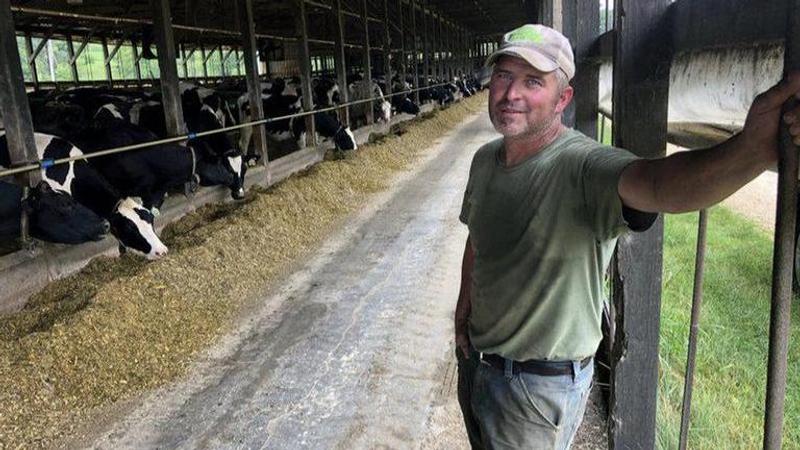Published 10:19 IST, August 22nd 2020
Democratic plan in rural, swing state counties: Lose by less
Jerry Volenec felt betrayed. Sold on Donald Trump’s pledge to help struggling Wisconsin dairy farmers, Volenec voted for the Republican. But within two years, Trump's trade pact with Canada had blocked the export of a good bit of Volenec's milk.

Advertisement
Jerry Volenec felt betrayed. Sold on Donald Trump’s pledge to help struggling Wisconsin dairy farmers, Volenec voted for the Republican. But within two years, Trump's trade pact with Canada had blocked the export of a good bit of Volenec's milk.
“It was a line in the sand. It said to me I was expendable,” Volenec said, as his shiny-coated Holsteins feasted on heaps of corn silage at his southwest Wisconsin farm. “As much as he says he loves the farmers, he loves us in so much as what we can do for him.”
Democrats are hoping to find just enough voters like Volenec to shave Trump's margins in rural areas while they rack up larger numbers in cities and suburbs. They have put in money in the millions and staff in the dozens to try to make it happen.
Their unorthodox strategy: win by losing by less.
“The general theory of the case goes like this: We’re trying not to lose as bad,” veteran Democratic strategist James Carville said of the rural and small-town counties Trump swung to his side in 2016. “Because when you don’t lose as bad at one thing, you can win everything.”
Carville has helped raise millions of dollars for Democratic super PAC American Bridge 21st Century’s $30 million advertising effort aimed at picking off voters in rural and working-class counties across Michigan, Pennsylvania and Wisconsin.
Trump carried all three states by about 77,000 votes out of 13.5 million cast. But in doing so, he peeled off 37 counties carried in 2012 by Barack Obama.
Trump likely must again win all three of the states, which the Democratic nominee had carried in six consecutive elections before 2016, if he is to get a second term.
Trump made a quick campaign stop Monday in Oshkosh, a hub in swing-voting east central Wisconsin, while Democrats were holding parts of their national convention in Milwaukee.
But American Bridge's effort is focusing more on the economically challenged Mississippi River Valley, 150 miles west.
Trump won Grant County, a fertile expanse of pastureland where Volenec works his fifth-generation farm and which went for Barack Obama in 2012.
It's part of a swath of western Wisconsin, similar to central Michigan and parts of rural and working-class Pennsylvania, where Democrats see Joe Biden simply losing by fewer votes than Hillary Clinton did in 2016 as a way to increase pressure on Trump in the swing regions and suburbs.
“The swing from 2012 to 2016, more than half of it, came from communities that cast 1,000 votes or fewer," Wisconsin Democratic Party Chair Ben Wikler said. That meant a shift of roughly 91,000 votes from Democrat to Republican in Wisconsin and about 123,000 in Michigan.
In all, American Bridge's map has grown over the summer to include 84 counties, more than half of the three states' total territory.
They include Bay County, Michigan, on Lake Huron, where Pat Steger backed Trump but has turned away because of what she calls his uneven support for his government's chief medical experts during the coronavirus pandemic.
Bay County, like neighboring Saginaw and Shiawassee, once contributed thousands of workers to a General Motors plant in Bay City. But like the Bay City plant itself, the union-based Democratic voting bloc has dwindled.
“I've come to realize I don't think he has the ability to step back, listen and absorb, as a leader during crisis should," said Steger, a 77-year-old retired administrative worker for a Bay City electric company.
Pecking away at these less populous regions is only one part of the fight for these three states that delivered the presidency for Trump. Trump's team is working to raise concerns about protests over racial injustice in GOP-leaning suburbs, while Biden is counting on a more energized urban outpouring than four years ago as he also chips into Trump's support in typically GOP-leaning suburbs.
That rests heavily on an outpouring from Democratic-heavy Milwaukee, Detroit, Philadelphia and Pittsburgh, where participation was down in 2016. Likewise, Democrats, who have made gains in suburbs, including Republican-leaning suburbs around Milwaukee, must continue making inroads with the younger and more racially and ethnically diverse families that have begun incrementally changing the profile of once vastly white suburbs and exurbs, especially around Milwaukee.
But Trump is also banking on squeezing as many votes as he did from northwest Wisconsin, northern Michigan and vast tracts of rural and small town Pennsylvania. For Democrats, winning back even a fraction of Trump's margin here along these rural roads and in shrunken manufacturing towns could be significant.
In 2018, Democrat Gretchen Whitmer took the Michigan governorship in part by picking up nine counties carried by Trump in 2016, including Bay County. In Wisconsin, Democratic Sen. Tammy Baldwin won reelection carrying 17 that Trump carried.
The successes are worrisome to Republicans, especially considering the tightening presidential race in swing-state Ohio, where Trump won by 8 percentage points but is seen as losing support in key suburbs while fighting to maintain near-historic margins in rural areas.
If Ohio is becoming more competitive, Trump faces an even greater task of holding his rural margins in Wisconsin where the outcome was much closer in 2016, said Mark Graul, a Wisconsin Republican strategist who ran George W. Bush's winning reelection campaign there in 2004.
“What worries me is for every one rural vote we pick up, we're losing two suburban votes,” Graul said. “And that math does not work well.”
10:19 IST, August 22nd 2020




